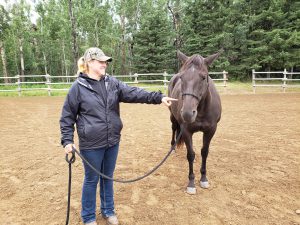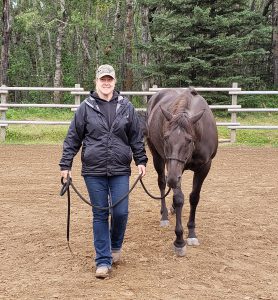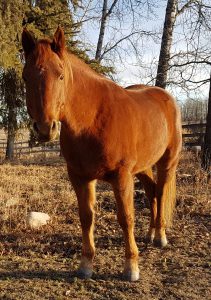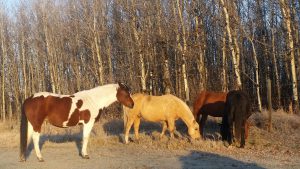Wow – an article on leading a horse. Seems a little trivial doesn’t it? Does it really matter where our horse is, or what they are doing when we’re leading them? It might not be a big deal to us, but the conversations that we have (or don’t have) when we’re leading them form the foundation of their entire social structure. It’s a big deal for our horse. With a little know-how we can use leading to form a corner stone of a solid leadership agreement with our horse – one in which they’ll trust and follow us, both in and out of the saddle.
Let’s start with a quick review of something we know: horses communicate primarily through space, energy and empathy.

Space. We all have personal space. When I ask folks what they consider to be their space, the answer is almost always the same: the length of their arm. To illustrate, consider how close a person could walk toward you until you feel uncomfortable. You’ll feel when they encroach on your space. Have you ever had someone – like a close-talker – walk toward you and you’ve backed up? That person has demonstrated ownership of their space by moving you with it. Instead, you could have pushed the other person away from you with your space. Again, this would demonstrate your ownership of the space.
We know that horses not only speak to each other through space – and the energy they put into it – they also use ownership of space to establish herd position. It’s a simple process.
Energy is something that can be put into a particular space to achieve a certain effect. For example a horse might put energy into the space to the left side of their hip to push another horse away in a certain direction. How much energy is put into that will dictate how much or how quickly the other horse moves.
Empathy is the ability to share or communicate a feeling. For example, one horse is scared so the other horses become scared; the herd leader relaxes so the herd around them does the same.
We’re going to focus on the spacial piece because it’s very important.
There are three different types of leadership relationships you can have with a horse:
- The horse believes they are above you in the herd order. You’ll see this when you go to lead your horse and your horse does not come with you; the lead rope gets strung out behind you as you walk away and the horse does not. This tells me that your horse is aware they own the space and can choose whether or not to follow you. If you get ahead of your horse and they do not work to catch up, then he’s assuming ownership of space behind you. The opposite (and more obvious) example is when the horse is physically leading you (ahead of you) and you’re working to catch up to him (or trying to hold him back).
- Your horse does not know who the leader is. This happens when you are inconsistent in your presentation. As an example, one day you might kick your horse out of your space when they try to come in, and the next day you let him barge into your space because she’s doing something you think is funny. From his perspective: on one day you were the leader and on the next day, they are. This drives horses crazy. When I hear someone say with respect to their horse on the ground that their horse is fussy, in my face or misbehaving, these are all clear indications that the horse is simply trying to get a clear response: where are you in the herd order? This is an easy question to answer for your horse. And in the few minutes it takes to answer that – with a clear and consistent demonstration of spacial ownership – you’ll find the fussiness is gone. In every clinic there is at least one horse/owner in this category, and within minutes the horse is calm and relaxed. We start our clinics off with a couple exercises to do this. These exercises are not done with anger or negativity – if we need to get bigger with a horse, we up our energetic presentation, not become angry or offensive.
- The horse is aware that you are the herd leader. A horse in this situation can follow you both mentally and physically. You can now begin to earn his trust by establishing credibility – precisely what we use our obstacle and trail courses for. Clearly this is what we desire!

Once we understand how horses use space and energy, and how they establish leadership, then it’s not difficult at all to clearly establish a herd position. We can now easily assess where our horse feels we are in the herd (above / unknown / below) by how they respond when we lead him or ask him to move.
What might not be apparent is that this leadership agreement or spacial ownership agreement can nurtured and maintained by something we all do: lead our horse from point A to point B.
Here’s the how and why behind that.
We know that spacial ownership dictates herd position. We humans are weak in noticing and handling tests, requests and changes in that space. This is because we primarily communicate via voice. Remember that horse primarily communicates through space and energy – not like us at all – so you can imaging how frustrating it might be for them when they’re looking for an answer in horse and you communicate in human. This is what will produce a fussy horse.
Horses have many similarities with people but also many differences. It’s important that we know what those are and gain an awareness that his language is not the same as ours. One notable difference is that a horse simply wants to know if the’re above you or below you in the herd order. They can be 100% comfortable with either – but he’s not comfortable with not knowing (inconsistency in your presentation).
We also know that some horses will test that leadership agreement. This can happen for three main reasons:
- You have worked with the horse to increase his confidence. When a horse really changes his confidence for the better, then it’s only natural that they are going to take that confidence into their social relations – climb the social ladder, so to speak. So, while confidence is what we desire, we also need to have an awareness that confidence might precipitate a change in herd order, and they might attempt that with us.
- The horse is a natural leader. Just as some folks gravitate toward leadership positions, so do some horses. Gaining the leadership role with a horse that is a natural leader can be a struggle, since they are not seeking leadership like a frightened horse would be. Because of that confidence, they might test your spacial agreement.
- Your spacial leadership is unclear: you begin to allow your horse to own space or take actions on his own that indicate she’s leading.

In any event, the horse might test your leadership agreement. These tests are generally subtle and folks typically ignore them. But by ignoring them, you might just be telling your horse that he’s above you in the herd, or that he’s gaining ground by owning more space.
Here’s an example: you’re leading your horse and she’s right beside you, where you want him. Then they sneak three inches ahead of you. If you do nothing and they stay three inches ahead, they now own that space. Again, to us, this little change might mean nothing. To him, it is a fundamental basis of his social structure; it’s huge in meaning. The same would be the case if the horse gets 3 inches behind.
The simple solution to this is to think that the horse has one job: to mirror you physically and mentally. It’s his only job. If you walk forward and pick your leg up, the horse should be doing the same. If you walk forward and your horse does not move then she’s no longer following/mirroring your leadership.
If following you is the horse’s job, then we can hold them accountable for that. If they start lagging by 3 inches, then we draw or send them forward 3 inches. If they get ahead of us 3 inches, then we use our space to push them back into their spot. When they’re in that spot we reward that by relaxing and providing them a positive feel, so that they know it’s the right spot.
It’s important that we retain a focus on where we’re going. When we’re looking forward, it’s easy to manage your horse’s position because you can use your peripheral vision to see instantly when your horse begins to get a head or fall behind. If you find that you are leading your horse and are looking at them, then likely they have done something to change your focus. When that happens, technically, they are now leading.
It might help to imagine that you have a beach ball and a bungee cord between your back and the horse’s chest. When they start to move forward, you’ll feel the space between you get smaller – the ball is being squished. Then, you push back on that ball. If they fall behind, you pull forward on that imaginary bungee cord. Your horse will feel you do both of those things. That doesn’t necessarily mean they’ll respond instantly though.
If they choose not to catch up when you have asked, then assist with a flick of your lead rope behind you and toward his hip OR use a stick that can reach his hind (if he’s getting ahead of you, use pressure toward his chest). You’ll do this without turning around – keep your eyes on where you’re going – because what you’re really doing here is asking your horse to follow your focus, energy and intent. You’re also answering his question about who holds the space by holding him accountable to be in a certain position.
 If you watch horses moving in a herd, you’ll see the exact same type of communication. The great thing about this style of horsemanship – and this type of communication – is that your horse already understands all of it; they are born with the ability to communicate with other horses.
If you watch horses moving in a herd, you’ll see the exact same type of communication. The great thing about this style of horsemanship – and this type of communication – is that your horse already understands all of it; they are born with the ability to communicate with other horses.
You might be thinking: what about directing him with the halter? Pulling forward or backward on the with the lead rope in order to put your horse in a position? Wiggling or jerking the lead ropes?
Well, we never see a horse pull another horse around with a halter as a means of directing him. They don’t need to because they are masters of space and energy. You can be one too. That said, do your best to not use the halter to direct your horse by pulling on the lead rope – that isn’t his language. Make sure to read my last article where we delve into the effects of tension in the lead rope or rein.
You’ll find a great feel in having your horse mirror you. Not only will they feel comfortable following you but he’ll strive to do so. Not only will you be confident in your leadership position, but you’ll take that relationship into the saddle. Imagine having your horse follow your focus and turn before you even pick up a rein. This type of following is normal for a horse – they do it 24/7 in the herd. All we need to do is learn a bit of their language and earn a trusted leadership position. Join us at a clinic to learn and practice these great tools!
Scott Phillips
August, 2018
